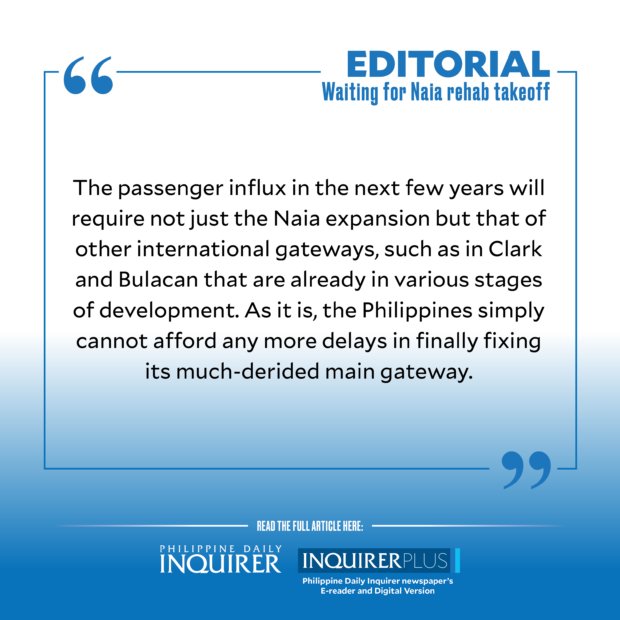Waiting for Naia rehab takeoff

If plans do not miscarry, the Marcos administration will sign the concession agreement with the private sector partner that will undertake the P170.6-billion rehabilitation of the aging and congested Ninoy Aquino International Airport (Naia) by March this year.
This tantalizing possibility that the modernization of the country’s primary gateway will finally take off after a number of false starts gives local and foreign travelers tired of putting up with the glitches and inconveniences that had long plagued Naia something to look forward to in 2024.
The Department of Transportation (DOTr) is fortunately not lacking in choices for a partner, with four formidable groups—Manila International Airport Consortium (Miac), Asian Airport Consortium, GMR Airports Consortium, and SMC SAP & Co. Consortium—submitting their bids for the contract to operate and maintain the country’s primary international gateway by the Dec. 27, 2023 deadline.
Article continues after this advertisementThe public bids and awards committee will proceed with the enormous task of combing through their voluminous proposals to ensure that the most technically and financially qualified among the bidders will be awarded the contract that will be effective for 15 years, with the possibility to be extended by another 10.
Long-standing capacity issues
The government must not and should not settle for a less qualified bidder as the Naia undertaking is massive, indeed.
Aside from making an upfront payment of P30 billion to the Manila International Airport Authority, plus an annual fixed payment of P2 billion during the concession period and a share of airport revenues, the “very important project” calls for the rehabilitation, expansion, and eventual operation of Naia to increase its handling capacity to 62 million passengers a year from the current 32 million and increase air traffic movement from 40 to 48 an hour.
Article continues after this advertisementThe expectation is that through this public-private partnership project, long-standing capacity issues will be solved enabling Naia to handle more flights and move passengers faster and more efficiently. This as demand for local and international air travel is projected to further climb as the economy returns to the path of fast growth.
As it is, Naia is already servicing about 45 million a year—about 94 percent of prepandemic volume—far beyond the design capacity of 32 million. No wonder then that it is bursting at the seams.
The travel experience of long-suffering travelers should also be dramatically improved at Naia with the help of the qualified private partner. No more long queues, lengthy waiting times, and uncomfortable waiting areas, which are major turnoffs thwarting the country’s ambitions of attracting more tourists used to far higher airport terminal standards.
Perennially at bottom rung
The DOTr has certainly made undeniable progress in pursuing the Naia rehabilitation project and yet cynicism remains, which is not exactly surprising. After all, this is not the first time that the government has attempted to level up Naia, which is perennially at the bottom rung of international airport rankings.
In recent years, Megawide Construction Corp. and its partner GMR Infrastructure Limited had made an unsolicited proposal to rehabilitate Naia and was initially given an original proponent status that was revoked in 2020 for unexplained reasons. Then last year, the Miac, composed of some of the country’s largest conglomerates, submitted its own P267-billion unsolicited bid to improve and take over Naia but it was set aside in favor of the solicited track wherein the government sets its own terms and invites bidders. This tack gave rise to other legitimate concerns.
Earlier, the Asian Development Bank, advisor to the DOTr, advised a one-month extension of the deadline for submission of bids as other foreign bidders wanted more time to prepare their proposals. The DOTr ultimately kept to the Dec. 27 deadline, thus Filipinos can only hope that the four choices will be a big enough pool to get the best.
Complicated Naia project
Then there are the questions over what law will ultimately govern the complicated Naia project. Currently, it adheres to the build-operate-transfer law, but then the Public-Private Partnership Code of the Philippines took effect on Dec. 23, 2023 and supersedes laws including the BOT law.Hopefully, the Marcos administration took this major development into account as it will likely come into play when questions rise over computations of a reasonable rate of return as well as contract disputes.
These legitimate concerns should be addressed as the bidding process continues but at the same time, these should not stop the government from seeing the privatization through once and for all.
The passenger influx in the next few years will require not just the Naia expansion but that of other international gateways, such as in Clark and Bulacan that are already in various stages of development. As it is, the Philippines simply cannot afford any more delays in finally fixing its much-derided main gateway.
















